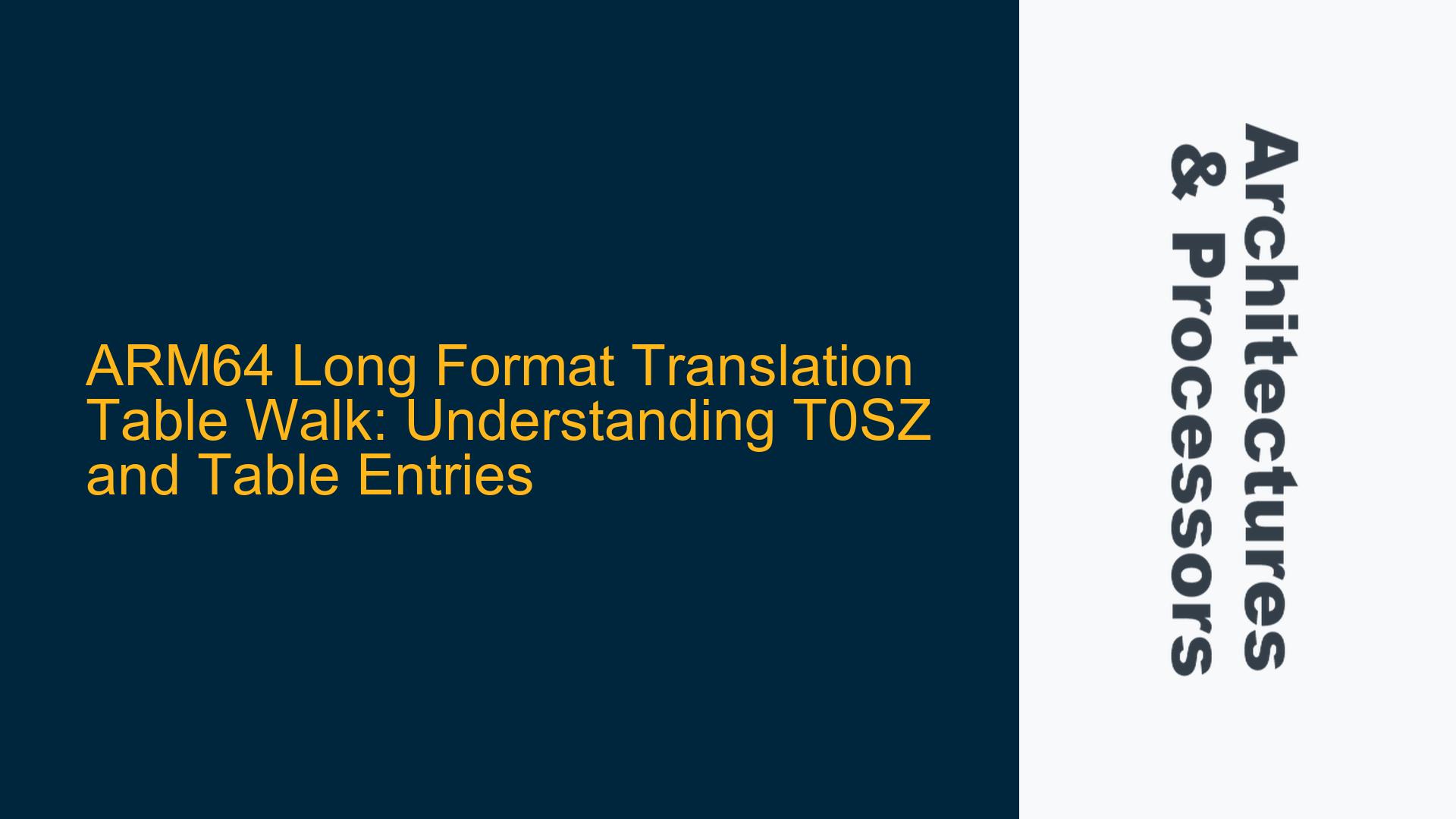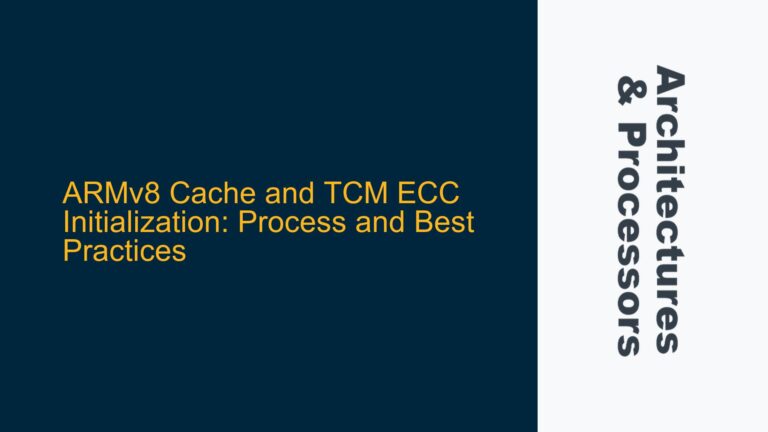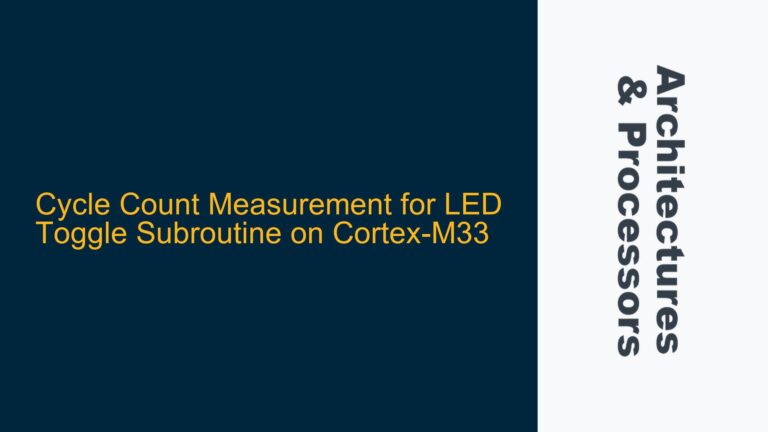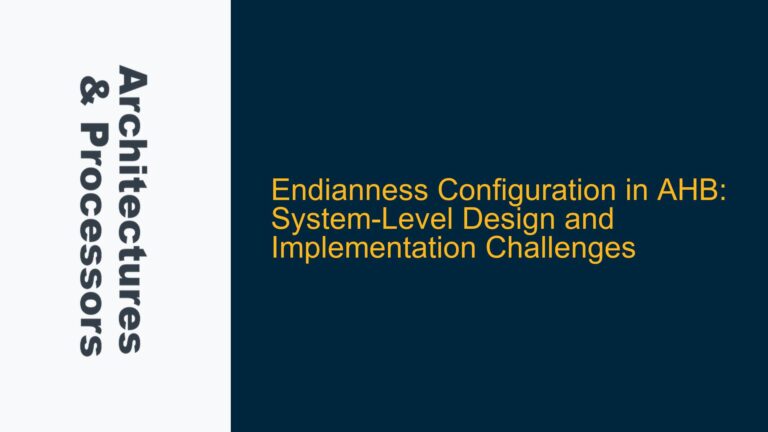ARM64 Stage 1 Translation Table Walk with T0SZ=38 and 4KB Granule Size
The ARM64 architecture employs a multi-level translation table walk mechanism to translate virtual addresses (VA) to physical addresses (PA). This process is critical for memory management in systems using ARMv8-A architecture. When dealing with Stage 1 translation, particularly with a T0SZ value of 38 and a 4KB granule size, understanding the structure and size of the translation tables at each level is essential. The T0SZ parameter defines the size of the memory region that can be addressed, and the granule size determines the smallest unit of memory that can be mapped. In this scenario, the translation starts at Level 2, and the number of entries in the Level 2 table, as well as the subsequent Level 3 tables, must be calculated accurately to ensure proper address translation.
The ARM Architecture Reference Manual for ARMv8 provides detailed information on the properties of the address lookup levels, including the number of entries in each translation table. For a 4KB granule size, the Level 2 table can have up to 512 entries, each of which is 8 bytes (64 bits) in size. This results in a total table size of 4KB, which aligns with the granule size. When T0SZ is set to 38, the number of valid virtual address bits is reduced to 26 (64 – 38). This reduction impacts the number of entries in the Level 1 table, which is determined by the number of bits available for indexing at that level. In this case, the Level 1 table has 5 bits for indexing, resulting in 2^5 = 32 entries.
Determining the Number of Entries in Level 2 and Level 3 Tables
The number of entries in the Level 2 and Level 3 tables is directly influenced by the granule size and the number of valid virtual address bits. For a 4KB granule size, the Level 2 table can have up to 512 entries, as each entry is 8 bytes, and the total table size is 4KB. This is calculated by dividing the granule size by the size of each entry: 4096 bytes / 8 bytes = 512 entries. The same logic applies to the Level 3 tables, which also have 512 entries each when using a 4KB granule size.
When T0SZ is set to 38, the number of valid virtual address bits is 26. This affects the number of entries in the Level 1 table, which is determined by the number of bits available for indexing at that level. In this case, the Level 1 table has 5 bits for indexing, resulting in 2^5 = 32 entries. The Level 2 table, which follows the Level 1 table, will have 32 entries as well, as determined by the number of bits available for indexing at that level. The Level 3 tables, which are used for the final stage of translation, will have 512 entries each, as determined by the granule size.
Implementing the Translation Table Walk with T0SZ=38 and 4KB Granule Size
To implement the translation table walk with T0SZ=38 and a 4KB granule size, the following steps must be taken:
-
Calculate the Number of Valid Virtual Address Bits: The number of valid virtual address bits is determined by subtracting T0SZ from the total number of bits in the virtual address. For T0SZ=38, the number of valid virtual address bits is 64 – 38 = 26.
-
Determine the Number of Entries in the Level 1 Table: The number of entries in the Level 1 table is determined by the number of bits available for indexing at that level. For 26 valid virtual address bits, the Level 1 table has 5 bits for indexing, resulting in 2^5 = 32 entries.
-
Determine the Number of Entries in the Level 2 Table: The Level 2 table follows the Level 1 table and will have the same number of entries as the Level 1 table, which is 32 entries in this case.
-
Determine the Number of Entries in the Level 3 Tables: The Level 3 tables are used for the final stage of translation and will have 512 entries each, as determined by the 4KB granule size.
-
Construct the Translation Tables: The translation tables must be constructed in memory, with each table containing the appropriate number of entries. The Level 1 table will have 32 entries, the Level 2 table will have 32 entries, and the Level 3 tables will have 512 entries each.
-
Perform the Translation Table Walk: The translation table walk begins at the Level 1 table, where the virtual address is used to index into the table. The entry at the indexed location contains the base address of the Level 2 table. The virtual address is then used to index into the Level 2 table, and the entry at that location contains the base address of the Level 3 table. Finally, the virtual address is used to index into the Level 3 table, and the entry at that location contains the physical address.
-
Handle Page Faults and Permissions: During the translation table walk, the system must check for page faults and ensure that the appropriate permissions are set for the memory regions being accessed. If a page fault occurs, the system must handle it appropriately, either by loading the required page into memory or by generating an exception.
-
Optimize for Performance: The translation table walk can be optimized for performance by using techniques such as caching the translation table entries in the Translation Lookaside Buffer (TLB) and using hardware acceleration for the table walk process.
By following these steps, the translation table walk can be implemented correctly for a system with T0SZ=38 and a 4KB granule size. This ensures that virtual addresses are translated to physical addresses accurately and efficiently, allowing the system to manage memory effectively.
Conclusion
Understanding the ARM64 Stage 1 translation table walk, particularly with T0SZ=38 and a 4KB granule size, is crucial for proper memory management in ARMv8-A systems. By calculating the number of valid virtual address bits and determining the number of entries in each translation table, the system can accurately translate virtual addresses to physical addresses. Implementing the translation table walk involves constructing the translation tables, performing the table walk, handling page faults and permissions, and optimizing for performance. By following these steps, the system can ensure reliable and efficient memory management, which is essential for the overall performance and stability of the system.






